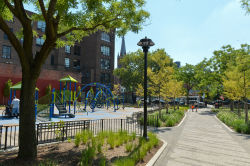Bartlett Playground
Bartlett Playground
What was here before?
The site was occupied by several three- and four-story tenement buildings until the early 1950s. The playground is on the southern edge of the Williamsburg neighborhood. First inhabited by the Lenape and then the Dutch, the area’s population boomed during the 18th and 19th centuries with the establishment of numerous refineries, breweries, and shipbuilding yards. The population expanded when the Williamsburg Bridge opened in 1903 and the arrival of immigrants from Europe, Puerto Rico, and the Dominican Republic. After a period of decline as heavy industry left the area, Williamsburg has seen a rebirth in the 21st century.
How did this site become a playground?
The City of New York acquired this land by condemnation in 1956 and opened as P.S. 168 Playground in 1960. This playground is a Jointly Operated Playground (JOP) serving P.S. 168 and the local community. Beginning in 1938, the Board of Education (now the Department of Education) agreed to provide land next to schools where NYC Parks could build and maintain playgrounds that could be used by the school during the day and by the public when school is not in session. In 1980, the Board of Education relinquished the underutilized school building, built in 1912, which is now privately owned and operated as United Talmudic Academy-Torah V'Yirah Satmar.
The playground is being rebuilt in 2021-22. In addition to new play equipment, plantings, and infrastructure, the playground was reconfigured to add an additional basketball court and a multi-use synthetic turf field.
Who is this playground named for?
In 1985, NYC Parks renamed this site in honor of Josiah Bartlett (1729-1795), signer of the Declaration of Independence and the first Governor of New Hampshire. Born the son of a shoemaker in Amesbury, Massachusetts, Bartlett began studying medicine at age 16. Five years later, he finished his studies and traveled to New Hampshire, where he established a medical practice in Kingston.
Bartlett was elected to New Hampshire’s legislature in 1765. He opposed the mercenary views of the royal governor, who in 1774 dismissed Bartlett as justice of the peace and removed him from his militia command. The following year, Bartlett was elected to represent New Hampshire at the Continental Congress in Yorktown, Virginia. He was re-elected in 1776 when the Congress relocated to Philadelphia, Pennsylvania. Since the Congress took votes beginning with the northernmost colony, Bartlett was the first to vote in favor of the resolution for a declaration of independence. He was re-elected again in 1778.
Although he had no legal training, Bartlett was appointed chief justice in the Court of Common Pleas in 1779, and from 1788-1790 he served as the chief justice of the Supreme Court of New Hampshire. Bartlett served in the convention for the ratification of the Constitution in 1788. He was elected as a Senator in 1789 but declined the position. In 1791, he was elected President of the State of New Hampshire, and became its first Governor when the title of the office was changed in 1792. Bartlett served as Governor until retiring from public service in 1794 and died the following year.
Check out your park's Vital Signs
Clean & Safe
Green & Resilient
Empowered & Engaged Users
Share your feedback or learn more about how this park is part of a
Vital Park System










